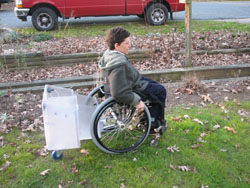Designers: Eric M. Spitz, Jordan M. Sadowsky, and John M. Schoenleber
Supervising Professor: Larry Bohs
 INTRODUCTION
INTRODUCTION
The Lawn Care Assisting Device (LCAD) helps our client, a woman who uses a manual wheelchair, to garden independently. The device’s irregular shape maximizes usable space and increases tool accessibility. The LCAD is composed primarily of Lexan, and uses swivel caster wheels for optimal maneuverability. A sturdy removable shelf and a rear flap maximize the device’s functionality. The LCAD easily attaches to and detaches from the wheelchair, and transports items such as a watering pail, gardening tools, and yard waste. Our client has successfully used the device to water her garden and transport piles of leaves, among other tasks.
SUMMARY OF IMPACT
The LCAD will enable our client to better enjoy one of her favorite pastimes. She commented, “This cart has made it so much easier for me to garden… I really appreciate it. It is great!”
TECHNICAL DESCRIPTION
The LCAD (Figure 1) easily attaches to our client’s manual wheelchair, allowing her to transport yard waste (such as leaves), carry tools (a rake, clippers, etc.), and carry a full water pail.The device consists of a narrower chamber that fits between the rear wheels of the wheelchair, and a larger primary chamber with a hinged rear flap. An elevated shelf within the primary chamber provides a convenient location for small tools and a watering can, within reach of the client while seated in her chair. An attachment hook holds the shelf on the side of the cart when it is removed to increase storage capacity of the main chamber. The chambers are constructed using 0.375″ Lexan walls and a 0.22″ polycarbonate base, attached rigidly using stainless steel, countersunk screws. Large rubber caster wheels are bolted onto the bottom of the cart, and the shelf, made from 0.375″ Lexan, rests on Lexan blocks. The rear flap, a 0.093″ sheet of Lexan, attaches to the base with a brass piano hinge. A lawnmower pull cord raises the flap, and magnets, inlayed into an upper crossbar, connect with metallic sheets inlayed into the flap to hold the flap in the upright position. The user can easily detach the flap by pushing, so it will lie like a ramp to allow the chambers to be filled with garden debris.
 The front attachment mechanism uses two tubes, which connect to the safety wheel attachment supports on the client’s wheelchair, providing support in the vertical and horizontal direction. A large hinged hook prevents the cart from pulling away from the wheelchair. Drainage holes allow water to drain from the chambers. A circular sander was used to smooth all corners and give the Lexan a scratch-resistant, foggy look. Cost of parts for the LCAD was approximately $480.
The front attachment mechanism uses two tubes, which connect to the safety wheel attachment supports on the client’s wheelchair, providing support in the vertical and horizontal direction. A large hinged hook prevents the cart from pulling away from the wheelchair. Drainage holes allow water to drain from the chambers. A circular sander was used to smooth all corners and give the Lexan a scratch-resistant, foggy look. Cost of parts for the LCAD was approximately $480.